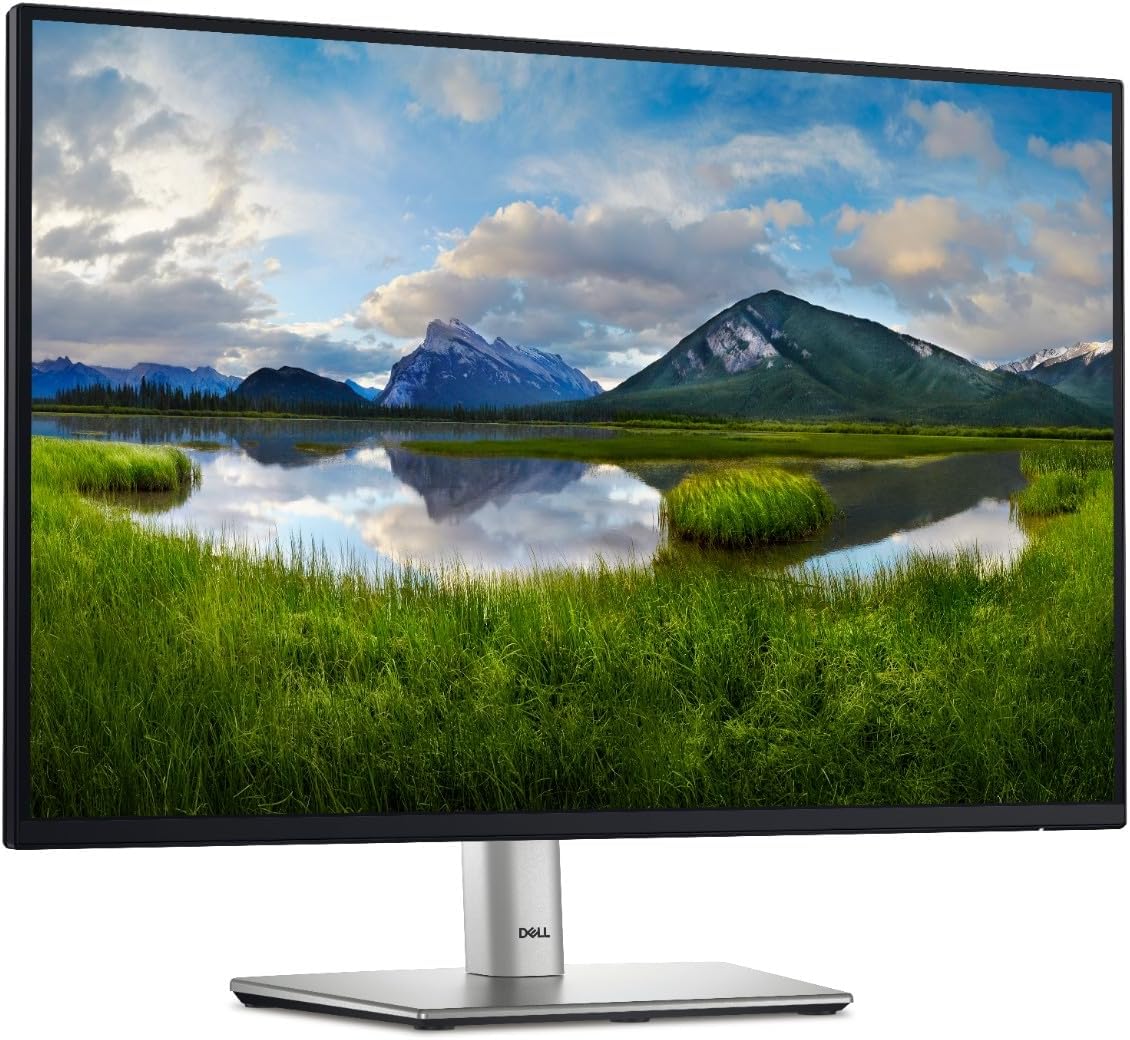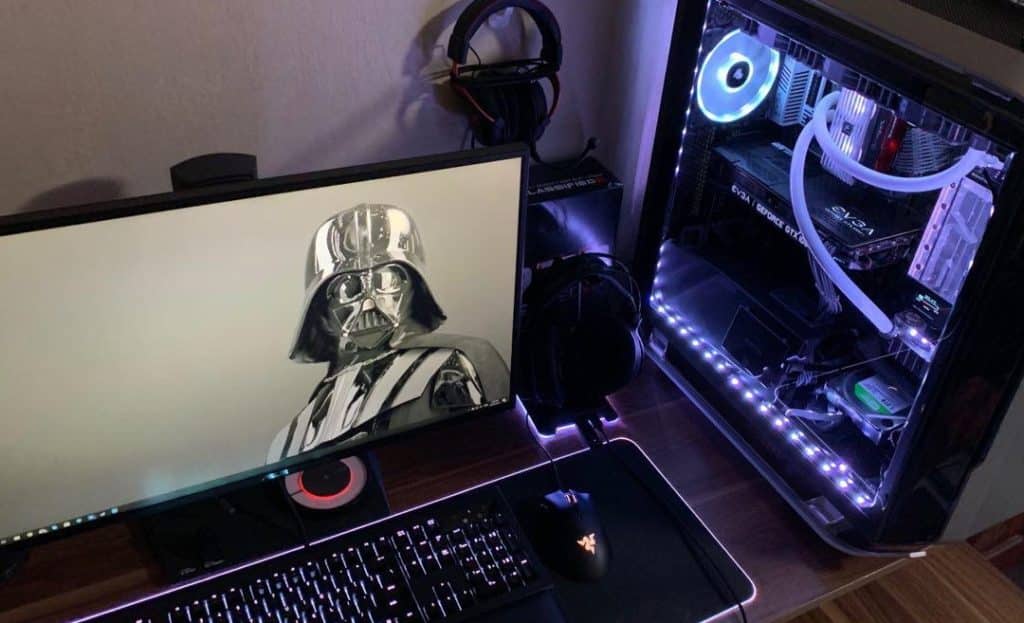The Dell P2425E offers essential features that makes a product the best possible option for a business or productivity setup. It also offers a few improvements over older monitors, such as its higher than usual contrast ratio. Its pricey for an office display, but let’s see if it makes a good long-term investment for your business or home office.
Dell P2425E Specifications
- Screen Size: 24 Inches
- Resolution: 1920 x 1200 WUXGA
- Aspect Ratio: 16:10
- Panel Technology: In-Plane Switching (IPS)
- Refresh Rate: 100Hz
- Response Time: 5ms
- Contrast Ratio: 1500:1 (Static)
- Brightness: 300 cd/m²
- Built-in Speakers: Yes (2 x 2 Watts)
- Stand: Height – Yes (5 Inches)
- Stand: Tilt – Yes
- Stand: Swivel – Yes
- Stand: Pivot – Yes
- VESA Compatibility: Yes 100 x 100
- Connectivity: DisplayPort 1.4 x 1, DP 1.4 Out x 1, USB-C PD90W x 1, USB-C PD15W x 1, HDMI 1.4x 1, USB 3.1 x 4, RJ45 x 1, Audio Jack x 1
- Dimensions with Stand(WxHxD): 20.94” x 14.33” x 7.16”
- Weight: 15.7 lbs
Design and Features
The Dell P2425E’s design hasn’t changed much from the brand’s previous offerings since aesthetics isn’t the only focus here. The monitor has a matte black finish with a silver base and stand, making it look more sophisticated than your average office display. The screen doesn’t have bezels, but it still has inner borders.
It is still basically a 24-inch monitor even if its slightly taller due to the 16:10 aspect ratio. It only needs 7.16 inches of depth, and around 21 inches wide, so placement should be easy even if you have tight spaces like table top VariDesk at the office. The whole unit weighs 15.7 pounds so it’s a bit heavier than most office displays, but its nothing most of us can handle.
The Dell P-series was intended for professional use, so it’s built with longevity and reliability in mind. The plastic panels are thick and sturdy, and there are no cosmetic defects on any of its parts. The included stand is firm and stable, so the screen doesn’t sag or wobble while it’s in use.
The Dell P2425E has an OSD joystick at the back for easy access to its settings and features. It’s located near the right lower corner of the screen, so it’s very easy to reach even if you can’t see it. It’s also compatible with Dell Display Manager, adding another layer of convenience for quick tweaks while crunching those numbers.
The included stand offers tilt, swivel, pivot, and height adjustments for your comfort and convenience. Its easy to get a comfortable viewing angle, even if you have more than one display on deck. You can use VESA mounts, but that’s only necessary in select instances like when your desk is smaller than the usual.
One of the highlights of the Dell P2425E is its connectivity layout, which is heavily equipped with functional options. You get DisplayPort 1.4 and DP Out 1.4 to match, a 90-watt USB-C port with DP Alt Mode, and HDMI 1.4 for video inputs. You also get four USB 3.2 slots, a 15-watt USB-C port, RJ45 LAN, and a 3.5mm audio jack for headphones.
The Dell P2425E doesn’t have speakers, so you have to spend more to get a fully-functional display option for your office. Dell sells a mini-soundbar that works with these displays, but that’s an added cost that might not be welcome for business purchases. Its better to just get headsets for remote meetings, although some models can be expensive too.
Display and Performance
The Dell P2425E sports a 24-inch IPS panel with a 1920 x 1200 resolution, a 100Hz refresh rate, and a 4ms response time. The backlight has a 300 cd/m2 output, while the contrast is listed at 1500:1, unlike most IPS monitors. This model is not equipped for HDR or certified for it, but that’s understandable since it’s not designed for entertainment.
The 1920 x 1200 panel isn’t noticeably sharper than a regular 1080p screen, but it has more pixels on the vertical plane. That means you get a taller viewing area, so it’s a bit nicer to work with when processing long documents or worksheets. It doesn’t need more GPU horsepower despite the higher pixel count, so you can run a lot of games with a basic setup on this monitor.
The Dell P2425E covers 100% of sRGB and 92% of DCI-P3 for excellent color in games and movies. Its default accuracy had a deltaE average of 1.77, so it’s already balanced out of the box. Most users won’t have to tinker with the monitor’s color settings, so its great for plug and play use.
Calibrating it reduced the dE average to 0.8, making it usable for editing and content creation. The downside is that you will need a colorimeter to achieve identical results, and those can be quite expensive for most users. We can only recommend it for color-critical work, but otherwise, the default settings should be good enough.
The Dell P2425E’s backlight reached 315 cd/m2 at 100% brightness, so it can fight off a decent amount of glare. Its contrast reached 1405:1 at 60% brightness, enabling it to produce better black luminance than its predecessors. It’s far from the results we saw on some of the latest IPS Black panels, but it’s still a noticeable improvement.
Panel uniformity for the test sample had some minor issues due to backlight leaks at the top edge of the screen. It resulted in some clouding in dark scenes, but it’s not noticeable in full-color or lighter images. Note that this can vary with every monitor made, so there are better and worse units out there.
The Dell P2425E’s pixel response time is noticeably better than its predecessors because it has a 100Hz refresh rate. Fast-paced scenes look smoother with less blurring, making the monitor capable enough for games. Its not designed for it, but at least its obvious that you can enjoy some after work play without worrying about smudges and persistence.
The Dell P2425E doesn’t have FreeSync, but it is not as necessary since the resolution is largely considered to be manageable. It does help for demanding games, but we don’t think the monitor’s intended audience will buy this for that. Its input lag sits at 5ms at 100Hz, so it is fast enough for any type of use.
Thoughts on the Dell P2425E
The Dell P2425E is an excellent example of a business monitor that’s suitable for long-term use. Its robust and reliable, and it comes equipped with modern and necessary features like USB-C for the environment its built for. It also boasts excellent imaging performance compared to other business monitors when it comes to color richness and contrast.
However, the Dell P2425E is quite expensive for an office monitor at its release MSRP. You can get a higher-resolution display for that price without skimping too much on essential features. However, there are only a few brands that are respected in the enterprise space, proving that this monitor will be a good investment for years to come.
Pros:
- Great Colors and Contrast for IPS
- Plenty of Connectivity Options
- Excellent Features
Cons:
- High Price
- No VRR
- Overall
About the Author: 





Leave a Reply